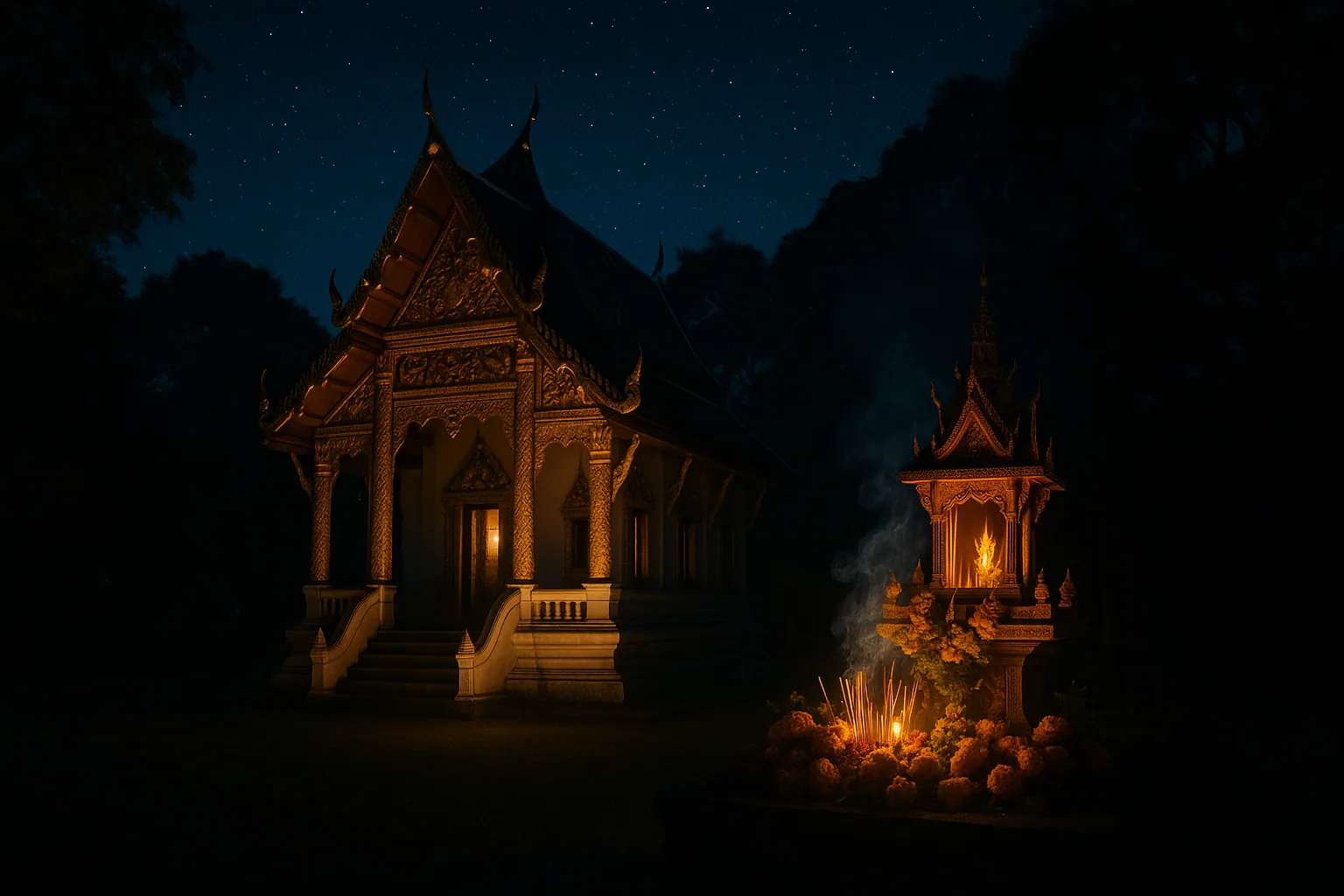
👻Thai Ghost Stories
How spirit beliefs shape Thai culture and daily life

How spirit beliefs shape Thai culture and daily life
It's past midnight in Bangkok when your Thai colleague casually mentions they won't visit that abandoned building—not because it's dangerous, but because phi live there. Ghosts. They say it matter-of-factly, the way you'd mention a traffic jam or a closed shop. This isn't superstition to them. It's reality, as concrete as the concrete itself.
Ghost beliefs in Thailand run deeper than most Westerners can immediately grasp. This isn't Halloween entertainment or folklore relegated to grandmothers' tales. Phi—spirits—occupy a genuine place in Thai cosmology, acknowledged by educated urbanites and rural farmers alike. These beliefs influence architecture, business decisions, social behavior, and even Thailand's thriving horror film industry. Understanding Thai ghost culture isn't just cultural trivia; it's a window into how Thais perceive the boundary between visible and invisible worlds.
What makes Thai ghost beliefs particularly fascinating is how they coexist with Buddhism. Thailand is devoutly Buddhist, yet spirit beliefs—many predating Buddhism's arrival—remain vibrantly alive. Monks bless buildings to ward off malevolent spirits. Spirit houses sit outside many homes and businesses, receiving daily offerings. Amulets blessed by revered monks are worn specifically for protection against ghosts. Rather than contradicting Buddhism, these practices form a parallel spiritual layer, addressing immediate supernatural concerns while Buddhism handles the larger questions of karma and rebirth.
"Ghost beliefs in Thailand aren't folklore relegated to the past—they're living spiritual reality that shapes how millions of Thais move through the world, from avoiding certain hours to blessing new homes."
Every culture has its iconic ghost story. America has its haunted houses. Japan has its onryō. Thailand has Mae Nak Phra Khanong, and her story commands a devotion that blurs the line between folklore and faith.
The tale dates to 19th century Bangkok. Nak, heavily pregnant, awaited her husband Mak's return from war. But childbirth went terribly wrong—both Nak and her baby died. When Mak finally came home, he found his wife and child waiting for him, alive and well. Or so it seemed. Neighbors tried to warn him that Nak was phi—a ghost—but she killed anyone who threatened to reveal the truth. Eventually, Mak discovered the horrifying reality: he'd been living with the spirits of his dead wife and child.
What happens next depends on which version you hear—there are dozens. In some tellings, a powerful monk subdues Mae Nak's spirit and binds it in a jar. In others, she's calmed by Buddhist teachings and releases her attachment to the living world. But the ending matters less than the emotion embedded in the story: desperate love refusing to accept death's finality, a devotion so powerful it transcends mortality itself.
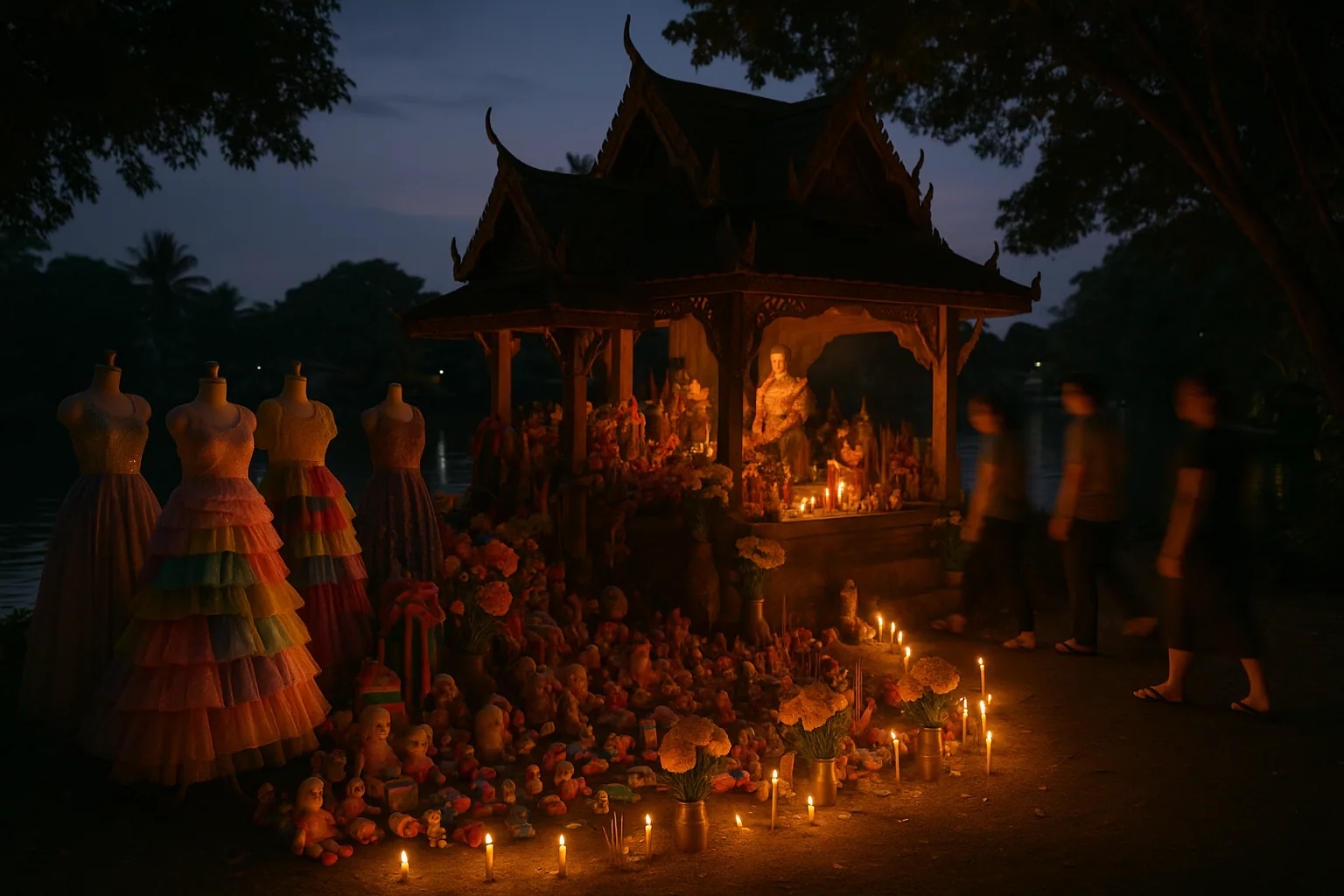
Today, Mae Nak's shrine at Wat Mahabut in Bangkok's Phra Khanong area (off Sukhumvit 77/On Nut Road) sees constant streams of visitors. Pregnant women leave offerings of dresses and toys, asking Mae Nak—the ghost who died in childbirth—for safe delivery. People pray to her for help with relationships, for protection, for blessings. This is where ghost belief transcends story: Mae Nak occupies a genuine place in contemporary spiritual practice, neither fully deity nor fully ghost, but something uniquely Thai.
The story has been adapted into dozens of films and TV dramas—more than 20 film versions alone—with new versions appearing every few years. The 1999 film "Nang Nak" became the highest-grossing Thai film of its time. Each generation reimagines Mae Nak, but the core remains: a love that death couldn't diminish, and a ghost who became part of living faith.
Thai ghost classification is remarkably specific. These aren't generic haunting spirits; they're categorized by how they died, what they want, and how they behave. Understanding these distinctions reveals how Thais conceptualize death, morality, and the supernatural.
Phi Tai Hong are perhaps the most feared—spirits of those who died violently, unexpectedly, or unjustly. Car accident victims, murder victims, women who died in childbirth: these deaths leave spirits earthbound and often vengeful. The logic is Buddhist: a sudden, violent death means the spirit had no time to prepare, to detach from worldly desires. They remain trapped, often at the location of death. This is why you'll see shrines at accident sites throughout Thailand—offerings to appease these restless spirits and prevent further tragedy.
→ Roadside shrines at accident sites with daily fresh offerings
→ Buildings with reputations for hauntings that fetch lower rents
→ Colleagues who avoid certain areas after dark, especially around 3am
→ Conversations about ghost experiences treated as normal, factual accounts
→ Monks regularly called to bless homes, offices, and new vehicles
Phi Krasue belongs to Thailand's horror pantheon but originates in rural folklore. Imagine a disembodied head trailing intestines and internal organs, glowing eerily as it floats through the night searching for blood, raw meat, or feces to consume. Gruesome, yes—but Krasue appears in countless Thai horror films and remains a genuine source of rural fear. The story goes that Krasue is usually a woman cursed, her head separating from her body each night. By dawn, she must reunite head and body or die. People lock away food at night and hang thorny plants near windows to snag the trailing entrails.
Phi Pop is more sinister still: a possessing spirit that enters bodies and consumes the victim from within, devouring organs slowly. Phi Pop accusations have led to real violence in rural areas—people suspected of harboring this spirit have been attacked or killed. This darker side of ghost belief reveals how spiritual fears can manifest in tragic ways.
Then there are Phi Am, the spirits that cause sleep paralysis by sitting on sleeping people's chests. That terrifying half-awake state is often explained in Thai belief as a visit from Phi Am. Phi Pret come from Buddhist cosmology—hungry ghosts depicted in Thai tradition as towering, skeletal figures with tiny mouths and distended stomachs, eternally starving as karmic punishment for greed in previous lives. They exist in a realm of suffering, and offerings during certain Buddhist festivals aim to provide them temporary relief.
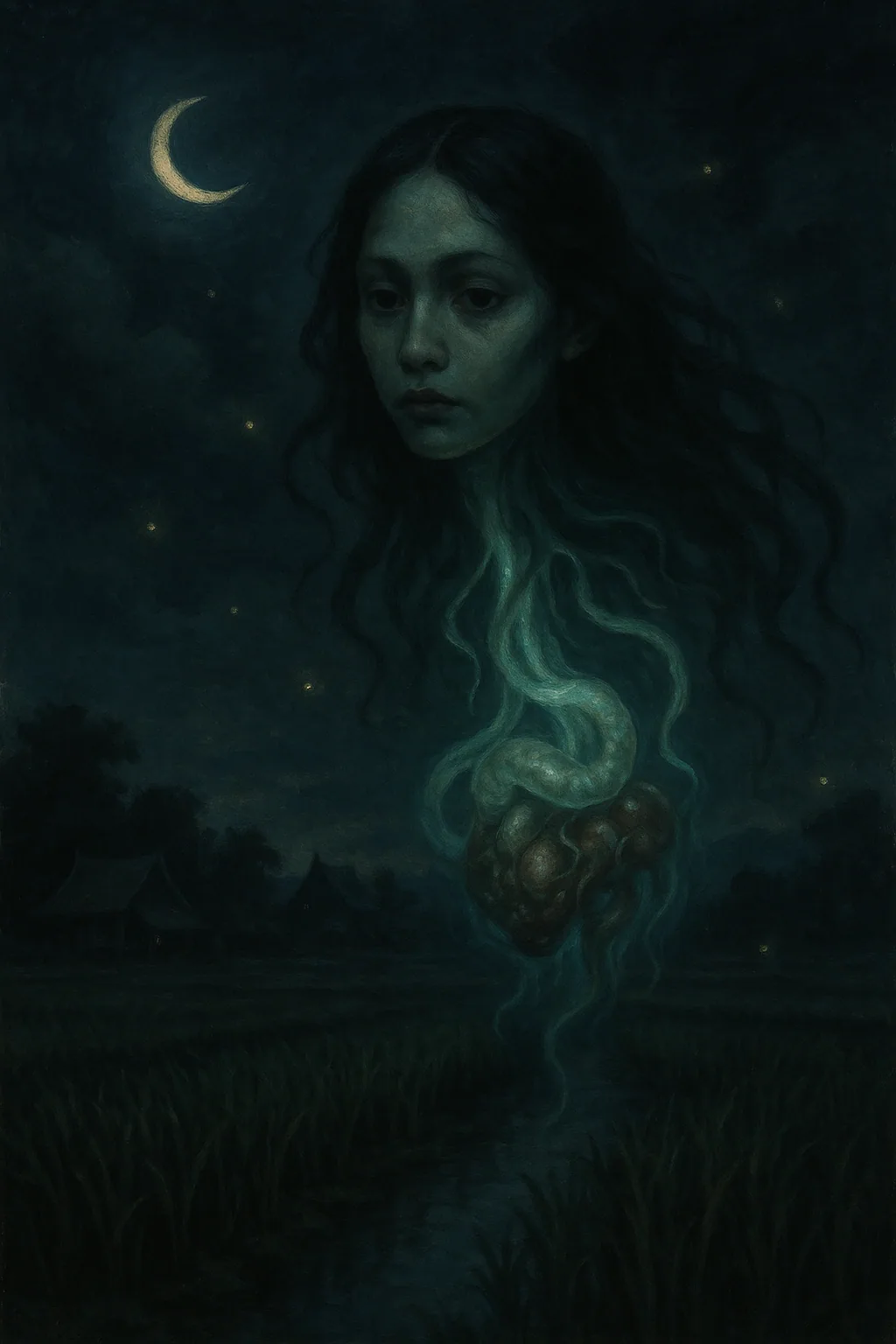
Thailand has developed one of Asia's most sophisticated horror film industries, and its success stems from genuine cultural belief. Thai horror isn't manufacturing fear from nothing—it's tapping into anxieties and stories that already live in the collective consciousness.
Films like "Shutter" (2004), which Hollywood remade, use distinctly Thai ghost logic: spirits captured in photographs, malevolent because of unjust deaths, seeking specific revenge rather than random scares. "Pee Mak" (2013) reimagined Mae Nak as comedy-horror and became Thailand's highest-grossing film ever—testament to how deeply the Mae Nak story resonates. Even played for laughs, audiences knew every beat of the tale.
What distinguishes Thai horror from Western or even other Asian horror is the underlying cosmology. Japanese horror often focuses on curses and grudges. American horror tends toward slashers or demons. Thai horror emerges from Buddhist and animist beliefs: karma, restless spirits, the consequences of moral failings, and the permeability between living and dead realms. The ghosts want something—justice, recognition, release—and understanding what they want matters.
Thai television hosts popular ghost-hunting shows where crews investigate haunted locations with mediums, monks, and equipment meant to capture paranormal evidence. These aren't fringe programs; they air in prime time and draw substantial audiences. The format treats ghost investigation as serious documentary work, not entertainment spectacle. You'll see monks brought in to provide spiritual protection, mediums attempting contact, and reactions of genuine fear from crew members who absolutely believe they're encountering real spirits.
For film enthusiasts: Start with "Shutter" (2004) and "Nang Nak" (1999) to understand how Thai horror builds on cultural ghost beliefs. "Pee Mak" offers a comedic take that reveals how embedded these stories are in Thai culture—the humor only works because everyone knows Mae Nak.
Haunted tourism: Bangkok offers ghost tours through Chinatown and other areas with reported hauntings. The abandoned Sathorn Unique Tower (also called Ghost Tower) became an urban exploration destination before being secured—though locals still avoid it after dark.
Respect boundaries: Thais take these beliefs seriously. Dismissing ghost stories as mere superstition can offend. Better to ask questions with genuine curiosity than skeptical mockery.
Ghost beliefs aren't abstract theology—they influence practical, everyday decisions. Building architecture incorporates spiritual considerations alongside structural ones. Before construction begins, land is typically blessed, and a spirit house is often erected to provide residence for displaced spirits. These aren't optional niceties; they're essential steps that most Thai developers wouldn't dream of skipping.
Certain buildings develop reputations for hauntings—former hospitals, sites of violent deaths, structures built on old cemeteries. These spaces often rent for significantly less, though some foreigners, unburdened by cultural ghost fears, happily claim the discount. Some Thais won't enter certain buildings regardless of price or convenience. It's not irrational fear to them; it's acknowledging a genuine spiritual danger.
Time carries spiritual significance too. Three in the morning is popularly treated in horror films and urban legends as "ghost hour"—the time when the boundary between living and dead is thinnest, when spirits are most active. Some Thais feel especially uneasy or spiritually cautious at this time, and if they must go out, they take extra spiritual precautions: wearing blessed amulets, keeping sacred thread on their person, avoiding calling out names in case spirits answer instead of humans.
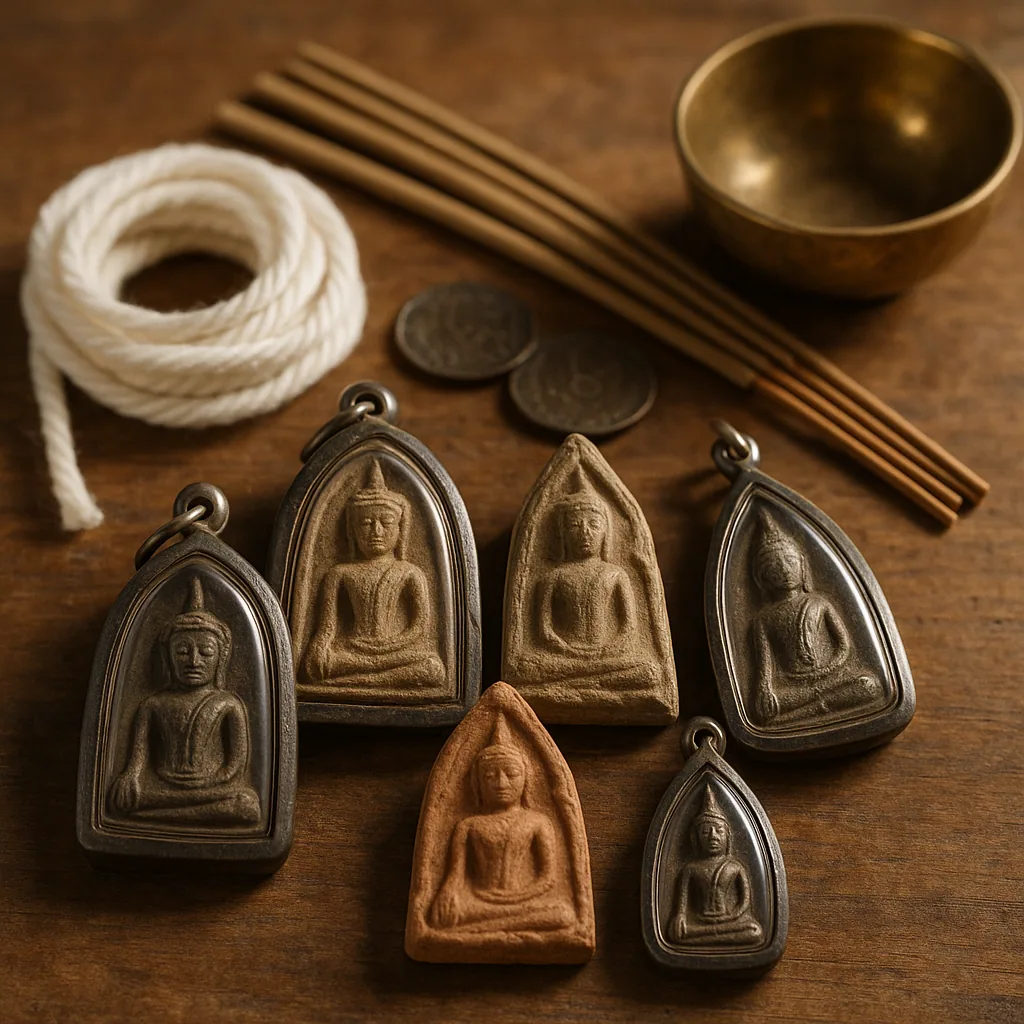
Protective practices pervade Thai life. Amulets blessed by revered monks are worn specifically for spiritual protection—against bad luck, yes, but also explicitly against ghosts and malevolent spirits. Some amulets from particularly powerful monks command extraordinary prices, thousands or even millions of baht, because believers trust in their protective power. White thread blessed by monks and tied around wrists or incorporated into buildings provides another layer of defense.
New homes and businesses receive thorough blessings before occupation. Monks chant, sprinkle holy water, sometimes perform specific rituals to ensure spirits won't cause problems. This isn't old-fashioned tradition maintained out of habit—it's active spiritual practice. Even educated, cosmopolitan Thais who've lived abroad often maintain these practices, viewing them as sensible spiritual hygiene rather than superstition.
Don't whistle at night—it's believed to attract ghosts. Avoid pointing at rainbows, as they're sometimes considered bridges to the spirit world. Don't sleep in the early evening (during sunset), as some believe ghosts may come and take your soul. These aren't universal rules, but many Thais follow them reflexively.
When spiritual problems arise—hauntings, repeated bad luck, illness that doctors can't diagnose—Thais turn to specific resources. Buddhist monks, particularly those with reputations for spiritual power, are called to perform blessings and exorcisms. The logic is that monks' spiritual purity and mastery of sacred texts gives them authority over restless spirits.
But Thailand also has a robust tradition of spirit mediums—people believed capable of communicating with or channeling spirits. These mediums operate in a space adjacent to Buddhism, drawing on animist and Brahmanical traditions. A family dealing with persistent bad luck might consult a medium to determine if angry spirits are involved and what offerings might appease them. Mediums also channel deceased relatives, allowing families to receive messages from the dead or resolve unfinished business.
This dual system—Buddhist monks and spirit mediums—reveals how Thai spirituality operates on multiple registers simultaneously. Buddhism provides the philosophical framework and ultimate spiritual goals. But for immediate supernatural concerns—ghosts in your house, cursed land, malevolent spirits—you might need different specialists with different knowledge sets. Both are considered legitimate, just addressing different aspects of the spiritual landscape.
You don't have to believe in Thai ghosts to live comfortably in Thailand. But dismissing these beliefs as primitive superstition misses something crucial about Thai culture. When your landlord insists on blessing your apartment, they're not being eccentric—they're following spiritual logic that feels as real to them as gravity feels to you.
Some expats find themselves gradually adopting certain practices, not from belief but from cultural immersion. You might start automatically performing a quick wai when passing temples, or feel oddly uneasy in that building everyone says is haunted, or find yourself avoiding whistling at night. Cultural context shapes perception in subtle ways.
More importantly, understanding ghost beliefs helps you understand broader Thai approaches to the unseen world. The careful offerings at spirit houses, the constant wearing of amulets, the consultation of astrologers before major decisions—these all emerge from a worldview where visible and invisible realms constantly interact. Respecting these beliefs, even if you don't share them, is part of respecting Thai culture itself.
Ghost stories also provide wonderful entry points for cultural conversation. Many Thais love sharing ghost experiences, and asking about local hauntings or famous ghost stories often leads to rich discussions about beliefs, regional folklore, and personal experiences. These conversations reveal aspects of Thai consciousness that remain invisible in tourist guidebooks.
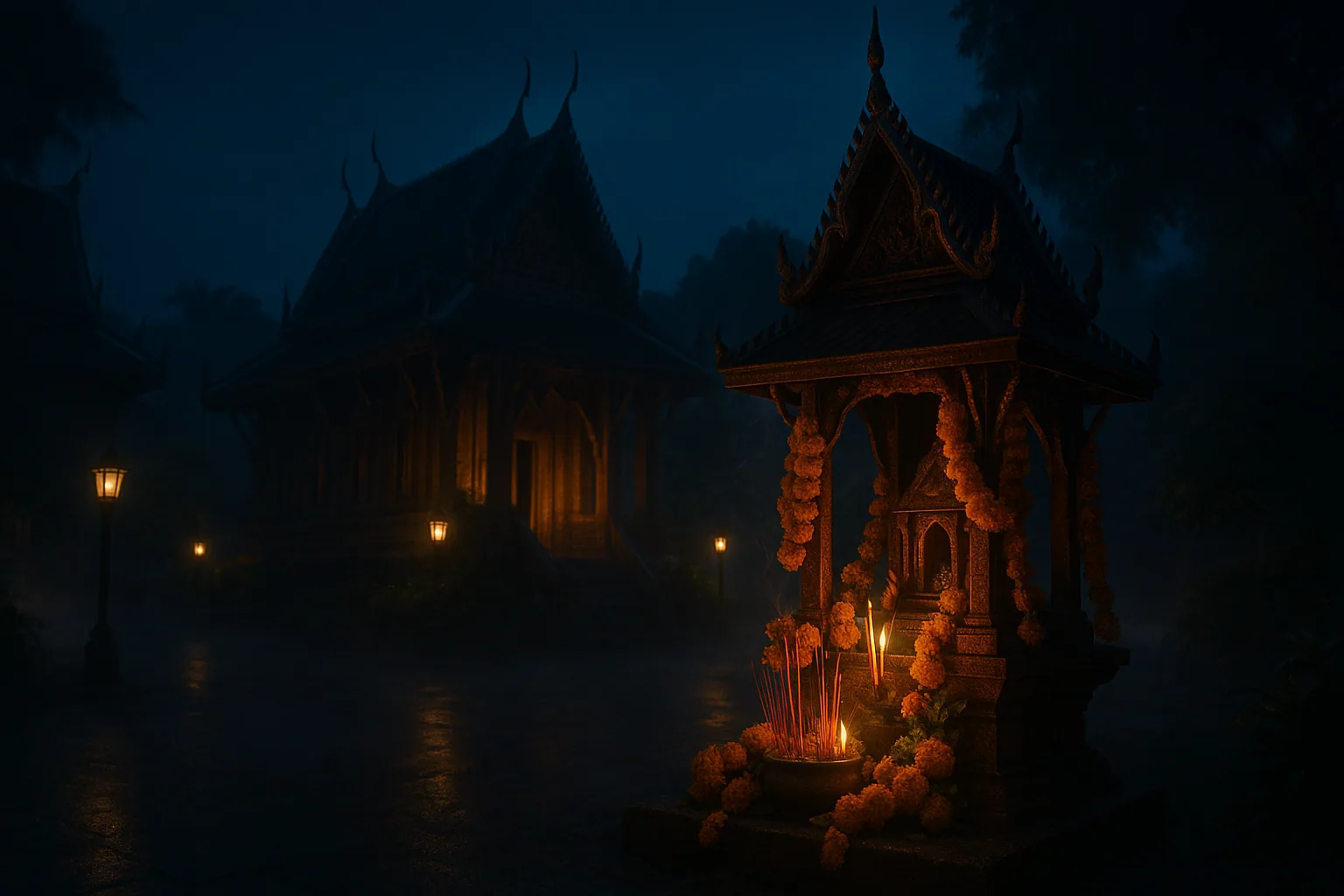
Whether you're navigating Thai customs in your first months or you've lived here for years, ghost beliefs offer insights into how many Thais understand death, morality, the past's persistence in the present, and the boundaries between worlds. Mae Nak still receives offerings at her shrine. Roadside shrines mark where violent deaths occurred. Spirit houses stand sentinel outside most buildings. The invisible world remains vivid and present in Thailand, acknowledged daily by millions who often see no contradiction between modern life and ancient spirits. Understanding this duality means understanding Thailand itself.
Mae Nak
Pregnant woman who died in childbirth, returned as ghost to wait for husband. Thailand's most famous ghost story, shrine at Wat Mahabut receives constant visitors.
Phi Krasue
Flying head with dangling entrails that glows at night, searching for blood and raw meat. Rural folklore that dominates Thai horror films.
Phi Tai Hong
Spirits of those who died violently or suddenly. Most feared category—earthbound, often vengeful, responsible for roadside shrines at accident sites.
Phi Pop
Possessing spirit that consumes victims from within. Accusations of harboring Phi Pop have led to real violence in rural areas.
Phi Am
Ghost that sits on sleeping people's chests causing sleep paralysis. That terrifying half-awake state is often attributed to Phi Am in Thai belief.
Cultural Note
These aren't just entertainment—many, perhaps most, Thais genuinely believe in ghosts or spirits and have personal experiences or know someone who does.
Phi (ผี)
General term for ghost or spirit
Phi Tai Hong (ผีตายโหง)
Violent death spirits, most feared
Phi Pret (ผีเปรต)
Hungry ghosts from Buddhist cosmology
Phi Krasue (ผีกระสือ)
Flying head ghost with entrails
Understanding these terms helps navigate conversations about Thai supernatural beliefs
→ Some avoid going out around 3am, considered "ghost hour" in Thai horror culture
→ Don't whistle at night—believed to attract ghosts
→ Don't answer mysterious calls at night; it might be a ghost calling you
→ Wear blessed amulets when visiting haunted or unfamiliar places
→ Pregnant women should avoid haunted sites and funerals